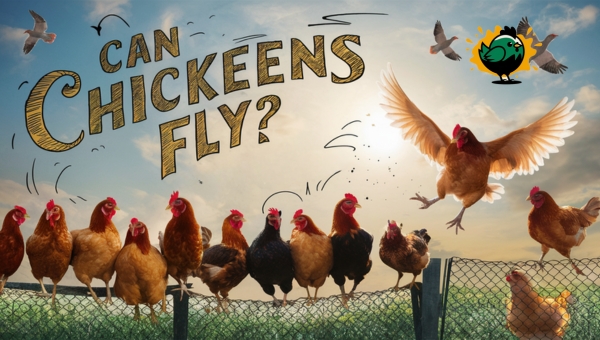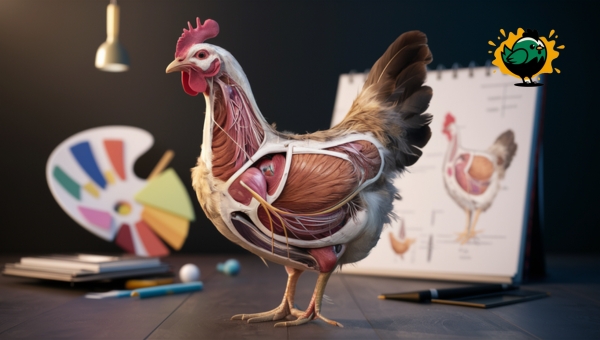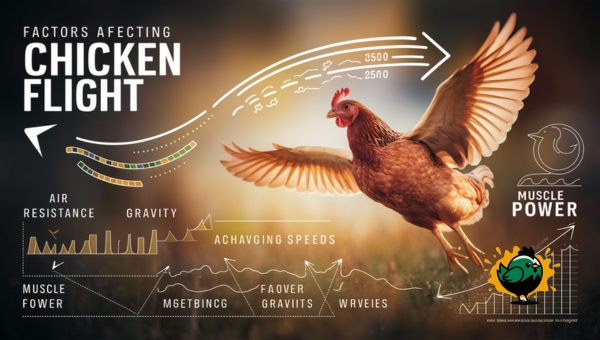Can Chickens Fly? Exploring Their Flight Capabilities

A sunny afternoon, the farm buzzing with life. You spot a chicken, wings flapping energetically, attempting what seems like a flight. This scene, although common, raises curiosity—can chickens fly?
As you ponder this, it’s essential to understand the anatomy and evolutionary history of these feathered creatures. Unlike birds soaring high, chickens possess unique adaptations that influence their flight capacity.
In this article, we will explore the fascinating world of chickens, dissect their anatomy, and delve into the factors affecting their ability to take to the skies. Let’s embark on this journey to unveil the intriguing truth about chicken flight.
Understanding Chicken Anatomy
Chickens are intriguing creatures with unique anatomical features that affect their ability to fly. Their wing structure and body weight play significant roles in determining their flight capacity. Let’s explore these aspects to understand why chickens are not known for their flying prowess.

Wing Structure
The anatomy of chicken wings is specifically designed for limited flight. Chickens have a lightweight skeletal structure, including a fused clavicle known as the furcula, which functions like a spring to support wing movement.
The wings consist of three main sections: the upper wing, lower wing, and wingtip. Each part contributes to its overall function during flight. Additionally, various feather types, such as primaries and secondaries, help generate lift during flapping motions. This unique structure allows chickens to achieve short bursts of flight rather than sustained flying.
Body Weight and Flight Capacity
A chicken’s body weight significantly impacts its ability to fly. Generally, heavier breeds struggle to sustain flight due to their mass, which surpasses the lift generated by their wings. While lighter breeds might manage short bursts of flight, the average domestic chicken is not built for long-distance flying.
This is due to their relatively high body weight compared to their wing size. As a result, chickens can only manage brief flights, often used for escaping immediate threats or reaching higher perches.
Also Read: Green Chicken Eggs – Genetics, Care, and Benefits
Evolutionary Background
Chickens have their roots in wild birds, which were once adept at flying. Over centuries, as these birds transitioned into domesticated chickens, selective breeding came into play. This breeding focused more on traits like meat and egg production, rather than flight capability.

As a result, modern chickens tend to have heavier bodies and wings that aren’t as strong as their wild ancestors. This shift in physical characteristics has made them less capable of lengthy flights.
Their evolutionary journey highlights the trade-offs between natural flight abilities and the demands of domestication. Understanding this background sheds light on why chickens today can only manage brief flights and are not the fliers their ancestors once were.
Factors Affecting Chicken Flight
Chickens, with their unique anatomy, often face challenges when it comes to flying. While they might have wings, several factors prevent them from soaring like other birds.

These factors can be broadly categorized into physical limitations and environmental influences. Let’s explore these aspects to understand why chickens have restricted flight abilities.
Physical Limitations
Several inherent physical characteristics limit a chicken’s ability to fly:
- Wing Structure: Their wings are not structured to produce enough lift for prolonged flight.
- Body Weight: Many breeds possess a body weight that exceeds the capacity their wings can support.
- Muscle Composition: Chickens typically lack the strong flight muscles that are found in better aerial birds.
Environmental Influences
The environment also plays a significant role in affecting a chicken’s flight capabilities:
- Space Availability: Open spaces provide more opportunities for take-off and landing than confined areas.
- Weather Conditions: Adverse weather like wind or rain can severely impact a chicken’s flight attempts.
- Predator Presence: The presence of predators can either discourage flight or prompt short bursts for escape.
Instances of Chicken Flight
When it comes to the flight capabilities of chickens, it’s a topic filled with curiosity. Chickens are not known for their ability to soar, yet there are moments when they do take to the air.
Let’s explore the scenarios where chickens manage to fly short distances, as well as the rare occasions when they achieve something more remarkable.
Short Distances and Low Heights
Chickens often engage in brief flights, and these are usually not very high or far. Here are some typical scenarios where you might see them in action:
- Escaping Danger: When threatened, chickens may flap their wings to make a quick getaway.
- Reaching Perches: They might fly up to a low branch or a coop perch for safety.
- Exploring: Short flights help them explore their environment or reach food that’s slightly out of reach.
Exceptional Cases
Although it’s uncommon, there are instances where chickens have achieved more significant flights. These rare moments can be quite surprising:
- Startled Responses: When suddenly frightened, some chickens can launch themselves to unexpected heights.
- Mating Displays: Certain breeds may exhibit longer flights during courtship rituals.
- Specific Breeds: Some lighter breeds occasionally manage flights over longer distances, showcasing a bit more of their avian heritage.
These instances of flight, while not indicative of a chicken’s natural aptitude for flying, highlight the diversity within the species.
Also Read: Fighting Chicks | Causes and How to Stop Aggression?
Benefits and Concerns of Chicken Flight
When discussing the flight capabilities of chickens, it’s important to explore both the advantages and potential challenges. Chickens’ limited flight ability plays a role in their survival and adaptation, particularly in terms of safety and farming practices. Understanding these aspects can help in managing chickens effectively.
Safety and Escaping Predators
- Chickens utilize short bursts of flight to escape predators, reaching higher ground swiftly.
- Flight aids in quick retreats, allowing chickens to evade threats in their environment.
- Perching on elevated areas is a common method for chickens to avoid ground-based dangers.
Impact on Farming Practices
- Farmers must account for flight when designing coops to prevent chickens from escaping.
- Adequate fencing and roofed enclosures help in containing chickens effectively.
- Balancing flight capabilities ensures chickens can express natural behaviors without compromising safety.
FAQs
Can chickens fly long distances?
Chickens are not built for long-distance flight. Their body structure and weight limit them to short flights, typically covering only a few feet at a time.
Why can some chickens fly better than others?
Some chickens can fly better due to differences in breed and weight. Lighter breeds with proportionately larger wings may achieve slightly longer flights compared to heavier ones.
How do chickens escape predators?
Chickens often escape predators by using their limited flight ability to reach higher ground. They may jump onto perches or branches to avoid danger quickly.
Conclusion
Chickens possess the anatomy and evolutionary background that limits their flight capabilities. Their wing structure and body weight play significant roles, with heavier birds struggling more. Although they can manage short flights, their ability to fly is restricted by physical and environmental factors.
Despite these limitations, flight serves essential purposes such as escaping predators and impacting farming practices. Understanding the nuances of chicken flight helps us appreciate these fascinating creatures. To explore more about the intriguing world of animals and their behaviors, dive into other insightful articles on our site, where knowledge awaits to be unveiled!
